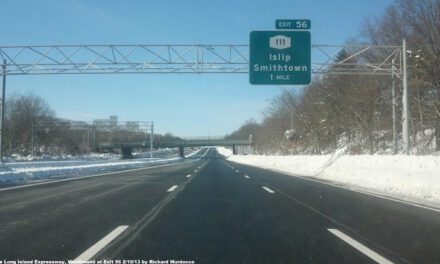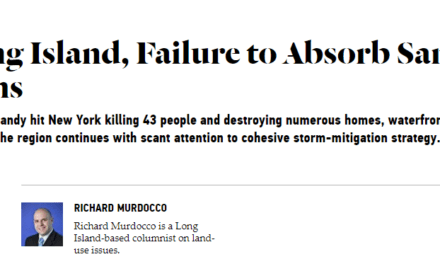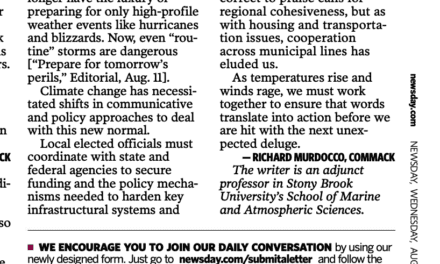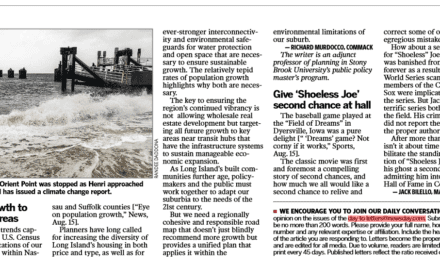The following was written for Boating Times Long Island, and published on March 1, 2016. You can read the original here.
When snow falls and canvasses Long Island’s suburbia, our hurried roads seem momentarily tranquil. In those fleeting moments, the chaos is muted, and neighborhoods bask in the relative silence.
Thereafter, the snowfall becomes an almost tragically different story of filth and inconvenience — that snow that was so peaceful becomes a burden to drivers stuck in clogged streets and pedestrians trying to navigate treacherous sidewalks. What was beautiful just hours before is now detested.
Along with making Long Island impassable, snow has another dark side. In our attempt to tame nature and get on the roads again, we plow and salt the snow. As the snow melts it takes different routes. Water, and the debris, dirt, and chemicals in its path, runs out to the Long Island Sound or the Great South Bay, or it’s absorbed into the ground, reentering the water table.
Snowmelt that is absorbed has a direct impact on Long Island’s sole-source aquifer system, which provides drinking water to residents (thanks to a complex series of geological issues and the former ancient positioning of the glaciers, groundwater absorption is optimal here). Depending on the year, snowfall can have anywhere from a minor to a marked impact on the reserves of water we have below our surface. During the winter, Long Island’s precipitation rates vary. According to data compiled by Newsday, annual snowfall on Long Island ranges greatly. For example, it was four-and-a-half inches from 1997 to 1998 and 90.75 inches in the winter of 1995 to 1996.
Salt and melted snow’s impact on our area’s groundwater supply and quality was explored in Suffolk County’s initial formal analysis in the late 1970s. By analyzing the impact development had on the fragile system, policymakers and planners concluded that issues like runoff (and eventually, the aftereffects of snow removal) are significant enough to try to regulate and curb.
In fact, parking lot and road runoff, as well as snowmelt in the winter and early spring months, are such prominent issues that the Long Island Expressway, the principal commercial and commuter corridor in the Nassau – Suffolk region, might not have been able to been built down the geographic “spine” of the Island starting in the 1930s if it was understood at the time how runoff impacts water quality.
Newsday reported in January 2015 in an article by Jennifer Barrios that agencies monitoring the effect of the salt (termed salt plumes) on groundwater have found that “road salt can increase the salinity of the groundwater in areas where the material is applied.” The United States Geological Survey’s Science Center in Coram has been tracking the issue; given the glacial pace of groundwater absorption, the plumes can take months, years, and even decades to impact wells.
The United States Geological Survey wasn’t the only entity to link road salting with drinking water contamination. It’s been on the radar of the local water authorities at least as far back as the 1980s when the Environmental Protection Agency issued the findings of a national urban runoff study which found often substantial seasonal increases of chloride after road salting (salt is sodium chloride) .
While melting snow with salt is an often-overlooked impact of development, it is clear that it has a tangible and measurable impact on water quality and coastal systems.
The New York State Department of Transportation has taken action to reduce the salt level and to judge the necessity for chemical application during each snowfall, but other meaningful action may be far off. When it comes to protecting the safety of the traveling public and the continuation of regional commerce after a storm, local governments have priorities that may not include environmental impacts. Alternatives to traditional road salt are expensive. According to the Suffolk County Water Authority, one alternative is calcium magnesium, but it costs 10 times as much as regular rock salt.
As a region, we must consider the impacts of unmitigated growth and realize just how fragile our groundwater aquifers are. The Northeast cannot avoid tough winters. To me, the real issue isn’t so much that we need to melt the snow but that there are so many roads to clear. Development, even smart growth that includes sewers, eventually gets snowed under, as there’s so little precious open space to offset the almost endless ribbons of asphalt that need to be cleared.














